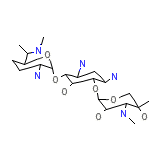Garamycin Otic Solution




Garamycin Otic Solution Brand names, Garamycin Otic Solution Analogs
Garamycin Otic Solution Brand Names Mixture
- Diprogen Crm (Betamethasone Dipropionate + Gentamicin Sulfate)
- Diprogen Ont (Betamethasone Dipropionate + Gentamicin Sulfate)
- Garasone Oph/Ot Sol (Betamethasone + Gentamicin Sulfate)
- Garasone Ophthalmic Ointment (Betamethasone + Gentamicin Sulfate)
- Gentamicin Sulfate in Nacl 0.9% Inj (Gentamicin Sulfate + Sodium Chloride)
- Gentamicin Sulfate in Nacl 0.9% Inj (Gentamicin Sulfate + Sodium Chloride)
- Gentocin Durafilm (Betamethasone 21-Acetate + Gentamicin Sulfate)
- Gentocin Otic Solution (Betamethasone + Gentamicin Sulfate)
- Otomax Ointment (Betamethasone + Clotrimazole + Gentamicin Sulfate)
- Sandoz Pentasone (Betamethasone + Gentamicin Sulfate)
- Topagen Ont (Betamethasone + Gentamicin Sulfate)
- Topagen Spray (Betamethasone + Gentamicin Sulfate)
- Valisone G Cream (Betamethasone + Gentamicin Sulfate)
- Valisone G Ointment (Betamethasone + Gentamicin Sulfate)
Garamycin Otic Solution Chemical_Formula
C21H43N5O7
Garamycin Otic Solution RX_link
http://www.rxlist.com/cgi/generic2/pedgenta.htm
Garamycin Otic Solution fda sheet
Garamycin Otic Solution msds (material safety sheet)
Garamycin Otic Solution Synthesis Reference
No information avaliable
Garamycin Otic Solution Molecular Weight
477.596 g/mol
Garamycin Otic Solution Melting Point
105°C (218-237°C as sulfate salt)
Garamycin Otic Solution H2O Solubility
100 mg/mL
Garamycin Otic Solution State
Solid
Garamycin Otic Solution LogP
-3.637
Garamycin Otic Solution Dosage Forms
Cream; Drops; Liquid; Ointment; Solution
Garamycin Otic Solution Indication
For treatment of serious infections caused by susceptible strains of the following microorganisms: P. aeruginosa, Proteus species (indole-positive and indole-negative), E. coli, Klebsiella-Enterobactor-Serratia species, Citrobacter species and Staphylococcus species (coagulase-positive and coagulase-negative).
Garamycin Otic Solution Pharmacology
Gentamicin is a broad spectrum aminoglycoside antibiotic. Aminoglycosides work by binding to the bacterial 30S ribosomal subunit, causing misreading of t-RNA, leaving the bacterium unable to synthesize proteins vital to its growth. Aminoglycosides are useful primarily in infections involving aerobic, Gram-negative bacteria, such as Pseudomonas, Acinetobacter, and Enterobacter. In addition, some mycobacteria, including the bacteria that cause tuberculosis, are susceptible to aminoglycosides. Infections caused by Gram-positive bacteria can also be treated with aminoglycosides, but other types of antibiotics are more potent and less damaging to the host. In the past the aminoglycosides have been used in conjunction with penicillin-related antibiotics in streptococcal infections for their synergistic effects, particularly in endocarditis. Aminoglycosides are mostly ineffective against anaerobic bacteria, fungi and viruses.
Garamycin Otic Solution Absorption
Injections lead to peak serum concentrations in 30-60 minutes. Topical gentamicin is readily absorbed from large burned, denuded, or granulating areas but not through intact skin. Absorption of gentamicin is faster and greater with the cream compared to the ointment. Gentamicin is absorbed in small quantities following topical application to the eye. Gentamicin is also absorbed in small amounts following topical application to the ear (especially if the eardrum is perforated or if tissue damage is present).
Garamycin Otic Solution side effects and Toxicity
Mouse, intravenous LD50: 52 mg/kg; rat, intravenous LD50: 96 mg/kg.
Garamycin Otic Solution Patient Information
No information avaliable
Garamycin Otic Solution Organisms Affected
Enteric bacteria and other eubacteria














